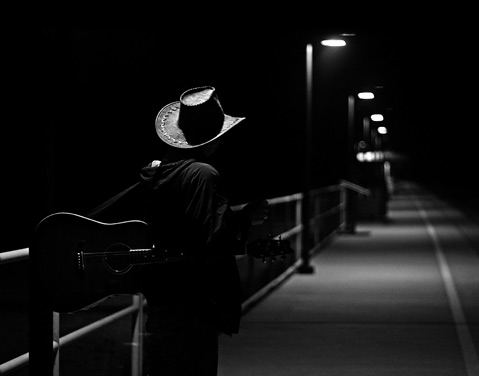W. Dibblee Hoyt: Far Reaches
Stirring Photos by a Teacher and His Students

How far do you have to travel to discover the romance of the Old West? If this show of wonderful photos by W. Dibblee Hoyt and his students from Allan Hancock College is any indication, the answer is no farther than Lompoc — if you know where to look. Hoyt began taking pictures on the San Julian Ranch he calls home several decades ago, riding out with the cowboys and sinking his camera deep into the life of the cattlemen as they herd, rope, and brand the animals that graze in the wilds of Gaviota. Like the land out of which it grew, Hoyt’s practice bore fruit, and the series of unforgettable, mostly black-and-white images that he created over the years became known throughout the North County. When he was approached by Allan Hancock College to teach, Hoyt accepted in the same humble spirit with which he followed his cattlemen, and the result was a full-on school of Dibblee, trained to get the shot even when the going was tough.
In this innovative and satisfying exhibition, curator Brett Leigh Dicks has brought together the best of Hoyt’s work with representative samples of photos taken by his Allan Hancock students. The show’s title, Far Reaches, reflects not only the distances Hoyt traveled in pursuit of his art — one set of images comes from a 1988 trip to the former Soviet Union — but also the far reach of the man as a teacher. And although they are all distinct and idiosyncratic in their styles, his students each indicate in some way what has been passed down to them through their interaction with this master of the lens.
In “The Traveler” from 2009, Sherrie Chavez uses heaps of negative space and a set of iconic elements to create a portrait that’s as genuine and deeply rooted as a Hank Williams song: It’s after dark, and a lone cowboy sits waiting on an empty train platform in the dark, with only his hat and his guitar to pick up the available light and give him shape in the gloom. It’s clear that Chavez learned something about how to isolate and inflect the essence of a man from Hoyt, who has a knack for discovering untold truths from unexpected angles. Any doubts about who knows cowboys best are laid to rest with Hoyt’s own iconic image of Rancho San Julian’s Jim Poett (also husband of Independent Editor in Chief Marianne Partridge) branding a calf. Before you go all soft with sympathy for this poor animal — I know, I know, it’s barbaric — consider for a moment that this 1997 shot captures, with its bold sculptural arrangement of diagonal forces, a practice that has been part of life in this area since before the Gold Rush and that continues to be upheld in an era when much more inhumane methods of raising cattle have become the norm. The picture has all the well-worn integrity of an old tool and provides a similar satisfaction to those who can see its fundamental worth.
Elsewhere in the show, the craft that Hoyt teaches appears through kindred approaches to abstraction. Cathy Gregg’s landscapes crackle with the same energy as the action shots, and Phyllis Daniels’s “Eucalyptus Swirl” (2006) spins a fine country tale out of contrasting shades of wood. The command of diagonals so evident in Hoyt’s ranch shots even invades Debbie Fuller’s brilliantly cropped image of kayaks in the Santa Barbara harbor — a far reach indeed for the influence of this talented artist and mentor.



